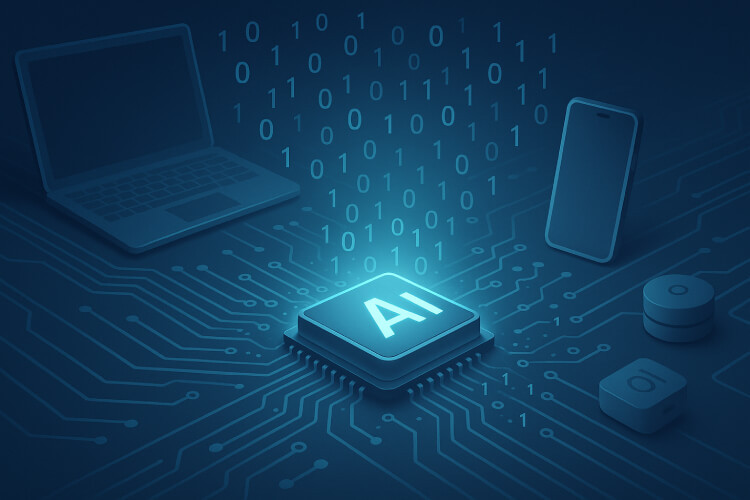1-bit LLM from Microsoft Rivals LLaMA in CPU Efficiency
Insights | 16-05-2025 | By Robin Mitchell

Key Things to Know:
- Microsoft’s BitNet b1.58 2B4T is the first open-source, 1.58-bit LLM capable of outperforming models like LLaMA 3.2 1B and Qwen2.5, while running efficiently on standard CPUs.
- Energy and memory efficiency: BitNet uses up to 96% less energy and only 0.4GB memory—making it ideal for low-power edge devices without GPU support.
- Advanced quantisation technology: Built from scratch with W1.58A8 quantisation and leveraging innovations like T-MAC and Ladder for efficient inference without multiplication.
- Practical edge AI applications: BitNet brings high-performance LLM capabilities to smartphones, laptops, and IoT devices—unlocking real-world deployment without cloud reliance.
While large language models (LLMs) have revolutionised artificial intelligence, their growing appetite for computational power and energy has sparked a parallel race: how to make them leaner, greener, and more accessible. With GPU requirements surging and energy demands climbing, running modern AI models has become increasingly unsustainable for many users.
In response, Microsoft researchers have unveiled a surprising breakthrough an LLM that runs on just 1.58 bits per weight, slashing energy use and memory requirements without sacrificing core performance.
What limitations do today’s LLMs face, what makes Microsoft’s BitNet model so different, and could 1-bit quantisation be the future of sustainable AI?
The Challenge with Modern LLMs
Artificial Intelligence has taken the world by storm over the past few years, and few would argue that the ignition point for this explosion was OpenAI's release of ChatGPT. Practically overnight, AI went from niche research papers and sci-fi movies to daily headlines, tech startups, and dinner table conversations. The buzz was inescapable and in fairness, the technology deserved the hype. Language models became an accessible tool for writing, coding, customer service, and every task in between.
However, it didn't take long for open-source projects to catch up. Meta's LLaMA series, for instance, cracked the door wide open by providing foundational models that anyone — and I mean anyone with a GitHub account and a GPU could fine-tune, retrain, or self-host. Open-source LLMs democratised the space, tearing down barriers that only months earlier had seemed insurmountable. In many ways, that open floodgate is the best thing that has happened to AI innovation. But it's not without its problems.
The Performance Bottleneck Behind Democratised AI
For all the brilliance and jaw-dropping capabilities these LLMs have shown, they carry one glaring Achilles' heel: processing power. No matter how clever the algorithms are, they're ultimately just highly sophisticated pattern matchers built on neural networks, and those networks demand a colossal number of parallel operations. In theory, your standard desktop could "run" an LLM. In practice, without specialised hardware like GPUs, you're in for a world of disappointment. CPU-only inferencing of modern models like LLaMA 3 or Mistral isn't just slow it's a complete non-starter.
And it gets worse. It's not enough to have a GPU; you need the right kind of GPU the ones equipped with massive pools of high-bandwidth memory. We're not talking about your gaming rig's 8GB card here. Hosting even a mid-sized LLM locally might require 24GB, 48GB, or even more VRAM, pushing you into workstation-class or data center-grade equipment. And with that comes wallet-punishing costs, both upfront and ongoing.
As if the hardware hurdle wasn't bad enough, there's a hidden tax too: energy consumption. Modern GPUs aren't exactly sipping power from the wall; they're more like jet engines at full throttle. When thousands (or millions) of individuals and organisations spin up local LLM instances or fine-tune models on beefy hardware, the global power draw adds up quickly. In fact, AI largely fuelled by LLMs, is rapidly becoming one of the fastest-growing contributors to carbon emissions in the tech sector.
Microsoft Demonstrates 1-bit LLM with performance greater than similar LLAMA
Microsoft has recently announced the development of a new AI model called BitNet b1.59 2B4T that is capable of performing complex tasks while using significantly less memory and energy compared to other models of similar size.
The most notable feature of BitNet b1.68 2B4T is its use of ternary quantisation, which reduces the number of bits used to represent each weight in the model from 16 or 32 to just 1.58 (representing -1, 0, or 1). This significantly reduces the memory requirements of the model, allowing it to run on standard CPUs instead of requiring high-end GPUs. In fact, the model is able to run on a single Apple M2 chip, which is a major improvement over other models of similar size that require specialised AI hardware.
Low-Bit Efficiency Without Sacrificing Performance
Microsoft's efficiency claims are reinforced by real-world benchmark results, where BitNet b1.58 2B4T exhibited latency of just 29ms on CPU decoding and energy consumption of 0.028J—metrics that outperform comparable models such as LLaMA 3.2 1B and Qwen 2.5 1.5B. This makes it particularly suited to constrained environments like edge devices or low-power laptops, where high-end GPU acceleration isn't viable.
In benchmark tests, the BitNet model has demonstrated strong performance across a range of tasks, including grade school math problems and questions that require common sense reasoning. In some cases, the model has even outperformed its rivals, including Meta's Llama 32 1B, Google's Gemma 3 13B, and Alibaba's Qwen 25 1.5B.
When tested on academic and general knowledge benchmarks such as ARC-Challenge, MMLU, and GSM8K, BitNet delivered accuracy levels on par with or exceeding those of larger, full-precision models. Notably, in the GSM8K benchmark, BitNet achieved a result of 58.38—higher than Qwen2.5 and MiniCPM, despite using significantly less computational resources.
Benchmark Accuracy Meets Energy Efficiency
By using simpler computations and reducing the number of bits used for each weight, the model is able to use significantly less energy than other models of similar size, which is estimated to be 85 to 96% less than full-precision models. As a result, the model can be run directly on personal devices without the need for cloud computing, which reduces the carbon footprint of AI systems and makes them more accessible to a wider range of users.
Technologies such as T-MAC and Ladder have further enabled BitNet’s energy savings by removing the need for multiplication in inference and supporting mixed-precision GEMM operations through lightweight lookup-based architectures. These innovations help the model operate efficiently even on CPUs with limited instruction sets, offering substantial reductions in overhead without compromising inference accuracy.
Engineering Innovations with Broader Research Impact
The development of the BitNet model also has implications for the field of AI research. By demonstrating that AI models can be trained to perform complex tasks using simple computations and reduced precision, researchers may be able to develop new models that are even more efficient and accessible. Additionally, the use of ternary quantised weights may provide a new direction for researchers looking to reduce the size and energy requirements of AI models.
Crucially, BitNet was trained from scratch using its quantisation scheme, rather than applying post-training compression. This native low-bit design ensures that the model's behaviour is stable across inference conditions, avoiding performance degradation common in retrofitted low-bit models. The design's reliance on W1.58A8 quantisation—1.58-bit ternary weights and 8-bit activations—offers a repeatable template for sustainable AI deployment.
Could 1-Bit Quantisation Be the Key to Future AI?
What Microsoft has demonstrated with their BitNet model is nothing short of brilliant. Compressing AI models down to nearly 1-bit precision, while still maintaining strong performance, is a major engineering achievement. For years, researchers have talked about reducing AI's hunger for compute and memory, but BitNet actually shows it can be done without turning the model into a barely-functional toy.
The implications for the low-power market are massive. Imagine running sophisticated AI models efficiently on battery-powered devices without needing specialised chips or cloud connections. It's no exaggeration to say that 1-bit quantisation could finally unlock practical AI for everything from smart home gadgets to industrial IoT systems. No more $2000 GPUs. No more building out server farms just to classify an image or process a few commands.
Unlocking AI at the Edge for Everyday Devices
Moreover, BitNet's ability to run effectively on a standard CPU and a consumer-grade one at that eliminates the need for power-hungry, high-memory GPUs in many real-world applications. That's a major win for sustainability, cost, and accessibility. It doesn't take an economist to realise that putting real AI in the hands of everyday users and devices will fundamentally shift the balance of where and how AI is deployed.
However, 1-bit models aren't the silver bullet for all of AI. While BitNet shows that lower precision is viable for many tasks, it will do little to replace very large language models (VLLMs), the massive, billion-parameter behemoths capable of true reasoning, problem solving, and detailed language generation.
In these heavyweight models, floating-point precision isn't just a luxury, it's essential. The ability to make ultra-fine adjustments to predictions based on subtle changes in input data is what separates a chatbot that feels like a parrot from one that can actually "think" and adapt on the fly. Try running GPT-4 on 1-bit weights, and you'll end up with something closer to a Magic 8-Ball than a conversation partner.
That being said, 1-bit quantised models are likely to dominate the consumer AI space in the near future. Expect to see models like BitNet show up in smartphones, wearable tech, smart appliances, and even microcontrollers. Think personal assistants, on-device image recognition, and edge computing tasks, all without needing a cloud connection or burning through a battery in an afternoon.
The bottom line is this: high-efficiency, low-precision AI models aren't about replacing the giants, they're about empowering the masses. And if that isn't the future we should be building, I don't know what is.

